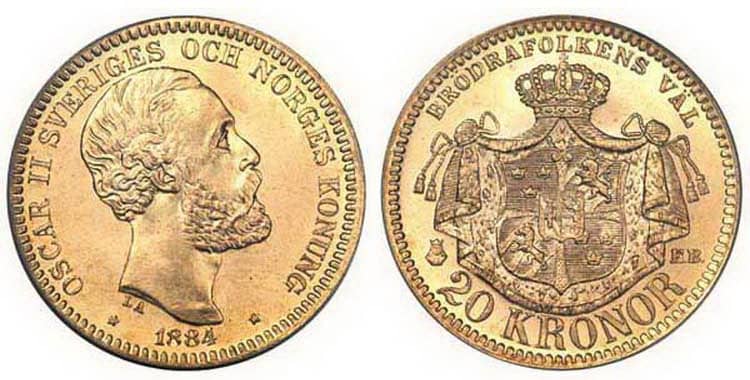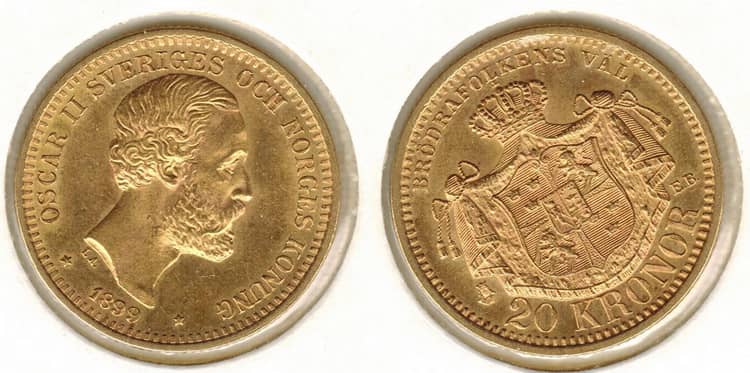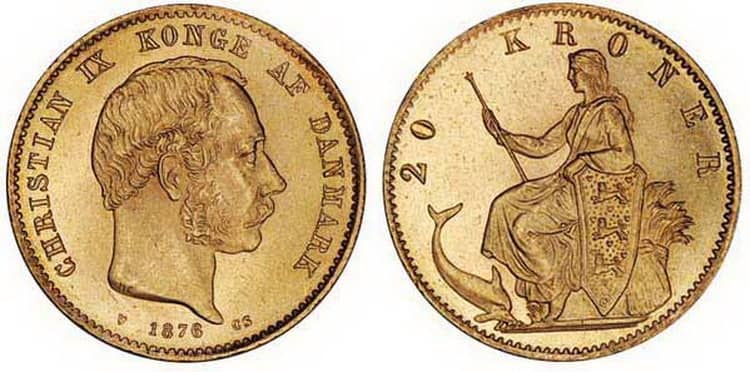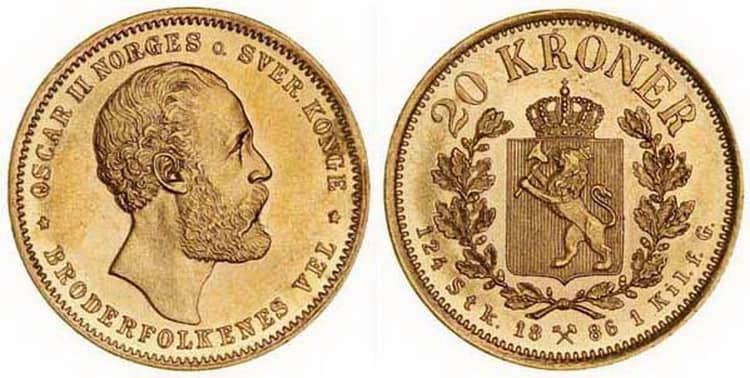
20 Swedish Kronor (1873-1902) is the old monetary unit of the Scandinavian Union. The new coin freely circulated in the three northern countries – Norway, Sweden and Denmark. For almost 30 years of minting, it has become the personification of stability and economic growth. After the collapse of the Union, Sweden retained the name of the currency.
History
In 1873, three countries – Sweden, Denmark and Norway – merged into the Scandinavian Monetary Union. This decision was made in order to simplify trade relations between states through the introduction of a common currency. Due to this, residents of Sweden could pay with new money in Norway and Denmark, like the euro. This Union was to ensure the stability of the new currency and economic growth, as well as to relieve inflation in connection with the transition to the gold standard.

Until that time, each country had its own silver currency in circulation. In Sweden, the riksdaler was the national currency, in Norway – the speciedaler, and in Denmark – the riksmint. Each currency had its own design, size, test and weight. At the same time, in Europe, all countries switched to the gold standard and equalized the value of their currencies relative to this precious metal. Therefore, a new coin was minted from gold. She received the name “krona”. The size, weight and sample were equalized. Gold 20 and 10 SEK (1873–1901) had circulation, but coins with a small denomination of 1, 2, and 5 kronor were more popular.
Did you know? Small coins dominated in the trade – 1, 2 or 5 Swedish kronor. Less than 10 were in demand SEK, and even less often 20 SEK. This is due to the fact that getting a salary in coins with large denominations was quite difficult. For example, a village servant received 10 kronor a year, a factory worker earned 10 Øre per hour (1/10 krona), a washerwoman — 2 kronor a day for hard work. An employee of the tobacco factory worked 58 hours a week and received 22 kronor for it.
The name of the Swedish krona is translated as “crown”. This word was borrowed from German. In Sweden, Denmark and Norway the name of the monetary unit was pronounced the same, but the spelling was different. In Sweden, the coin was minted “Krone”, the inscription “Krona” was present in Danish and Norwegian. Even such insignificant differences did not prevent the participants of the Scandinavian Union to freely pay with coins of their own country in the territory of neighboring states and receive a change.
Did you know? By tradition, all Swedish coins were minted with a portrait of the current monarch. King Oskar II was present at the crowns of Sweden and Norway, and King Christian X was present at the Danish currency. The Royal Mint in Stockholm was engaged in production, as evidenced by the barely visible image of St. Eric, the patron saint of Swedish lands. 20 Norwegian kronor were identical to the Swedish ones, but it was possible to distinguish by the Mintmark of the Mint of Christiania (the future Oslo) – by two intersecting hammers.
The Scandinavian Union lost its importance in 1924, when the contract expired. But 20 Swedish kronor of 1873-1902 ceased to be minted much earlier. This is due to the World War I and the need to spend gold on military needs. The production stopped using precious metal, and instead coins were minted from nickel.
Design
Gold and silver coins of Sweden differed with exquisite beauty and classic design. On the front side there was a portrait of the monarch, and on the back side – the emblem and denomination. Also on the coin minted the king’s motto. Before the collapse of the union between Sweden and Norway, and King Oscar II lost his legal right to possession of Norway, the motto on 20 Swedish kronor read: “BRODRAFOLKENS VAL). After that, he changed to “GOOD SWEDEN” (SVERIGES VAL).

Different engravers worked alternately on 20 Swedish kronor of 1873-1902:
- 1855-1905 – Lea Ahlborn is a talented artist and the first female engraver in Sweden. Her initials on Swedish kronor were denoted as L.A.
- 1897-1942 – Adolf Lindberg – medalist, student L. Ahlborn. Coins with his initials A.L. were minted for 26 years after his death.
- 1876-1909 – Emil Brusevich. His work can be recognized by the initials E.B.
Characteristics of 20 SEK 1873-1902
Metal: gold.
Composition: 90% gold, 10% copper.
Sample: 0,900.
Weight: 8.9606 grams.
Diameter: 23 mm.
Thickness: 1.2 mm.
Edge: ribbed.
Quality: Regular release (Unc).
The authenticity of the portraits and the many elaborate details made it impossible for counterfeiters to fake it. But due to the fact that 20 Swedish kronor was a running coin, it was quickly worn out and was unusable. Even in this state, the currency is easy to identify. At present, it is quite difficult to find an old copy of good quality.
Did you know? Despite the fact that the salary in Sweden was low, any resident of the country could provide themselves with food. Agriculture developed rapidly in the years 1880-1910, therefore, products of animal and vegetable origin were acceptable. A liter of milk – 14 øre, butter – 1.82 kronor, salty meat – 69 øre per kilogram. The one could buy 13 eggs, 4 kg of rye flour, 600 grams of coffee, 800 grams of pork, 600 grams of beef fpr one krona
Obverse: In the center there is a portrait of King Oscar II, head turned to the right. From right to left is the inscription that determines the status of the monarch – “OSCAR II SVERIGES OCH NORGES KONUNG” (in translation – OSCAR II SWEDISH AND NORWEGIAN KING). Along the bottom is the year of embossing, enclosed in symbols.

Reverse: On the reverse side, almost the entire place is occupied by the national emblem of Sweden – an azure shield divided by a cross into four parts, the coat of arms of the royal house is located in the center. The shield is crowned with a royal crown. To the left of the national emblem in the lower part a barely noticeable portrait of St. Eric is struck, and to the right are the engraver’s initials. On the upper edge there is the inscription “BRODRAFOLKENS VAL” (translated as WELFARE OF BRATURE PEOPLES). Below are the denomination and the name of the coin “20 KRONOR”.
Circulation
20 Swedish kronor of 1873-1901 were minted in large quantities, but they were not issued every year. Many coins did not survive, because they were melted into bars:
- 1873 – 115 108 pieces;
- 1874 – 239,500 pieces;
- 1875 – 359,280 pieces;
- 1876 – 67,000 pieces;
- 1877 – 83,408 pieces;
- 1878 – 245,000 pieces;
- 1879 – 75,250 pieces;
- 1880 – 127,250 pieces;
- 1881 – 47,250 pieces;
- 1884 – 190,750 pieces;
- 1885 – 6,250 pieces;
- 1886 – 172 809 pieces;
- 1887 – 58,737 pieces;
- 1889 – 201 500 pieces;
- 1890 – 155,491 pieces;
- 1895 – 134 660 pieces;
- 1898 – 313 497 pieces;
- 1899 – 260 848 pieces;
- 1900 – 104 199 pieces;
- 1901 – 226,679 pieces;
- 1902 – 113,810 pieces.
Did you know? The design of the 20 Swedish kronor of 1873-1902 was constantly brought about by minor changes. For nearly 30 years, new engravers added barely noticeable details, and also replaced the initials of the previous authors with their own. In 1877, the inscription “OSCAR II SVERIGES OCH NORGES KONUNG” abolished the writing “OCH” on 20 Swedish kronor, replacing it with “O. “. In the same year, two batches of coins with “OCH” and “O.” were minted.
Cost of coins
On sale it is rare to find 20 SEK of 1873-1901 in acceptable quality. Well-preserved samples cost about $ USD 560-600. A copy in poor quality will cost $ USD 300-400.
Comments
No commens yet.